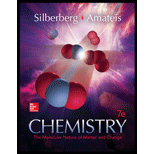
Concept explainers
(a)
Interpretation:
Whether the appearance of purple vapor when solid iodine is warmed is a physical change or a chemical change is to be determined.
Concept introduction:
The change that takes place only in state or appearance and not in the composition is known as physical change. The atoms or the molecules of a substance do not change their identity when a substance undergoes a physical change. The change accompanied by the change in the physical properties only is classified as physical change. The substance remains the same before and after the change. For example, the melting of ice is a physical change.
The change that takes place in the composition is known as chemical change. The atoms or the molecules of the substance rearrange and transformed into a new substance. For example, the burning of paper is a chemical change.
(b)
Interpretation:
Whether the ignition of gasoline fumes by a spark in an automobile engine’s cylinder is a physical change or a chemical change is to be determined.
Concept introduction:
The change that takes place only in state or appearance and not in the composition is known as physical change. The atoms or the molecules of a substance do not change their identity when a substance undergoes a physical change. The change accompanied by the change in the physical properties only is classified as physical change. The substance remains the same before and after the change. For example, the melting of ice is a physical change.
The change that takes place in the composition is known as chemical change. The atoms or the molecules of the substance rearrange and transformed into a new substance. For example, the burning of paper is a chemical change.
(c)
Interpretation:
Whether the formation of scab over an open cut is a physical change or a chemical change is to be determined.
Concept introduction:
The change that takes place only in state or appearance and not in the composition is known as physical change. The atoms or the molecules of a substance do not change their identity when a substance undergoes a physical change. The change accompanied by the change in the physical properties only is classified as physical change. The substance remains the same before and after the change. For example, the melting of ice is a physical change.
The change that takes place in the composition is known as chemical change. The atoms or the molecules of the substance rearrange and transformed into a new substance. For example, the burning of paper is a chemical change.
Want to see the full answer?
Check out a sample textbook solution
Chapter 1 Solutions
Student Study Guide for Silberberg Chemistry: The Molecular Nature of Matter and Change
 ChemistryChemistryISBN:9781305957404Author:Steven S. Zumdahl, Susan A. Zumdahl, Donald J. DeCostePublisher:Cengage Learning
ChemistryChemistryISBN:9781305957404Author:Steven S. Zumdahl, Susan A. Zumdahl, Donald J. DeCostePublisher:Cengage Learning ChemistryChemistryISBN:9781259911156Author:Raymond Chang Dr., Jason Overby ProfessorPublisher:McGraw-Hill Education
ChemistryChemistryISBN:9781259911156Author:Raymond Chang Dr., Jason Overby ProfessorPublisher:McGraw-Hill Education Principles of Instrumental AnalysisChemistryISBN:9781305577213Author:Douglas A. Skoog, F. James Holler, Stanley R. CrouchPublisher:Cengage Learning
Principles of Instrumental AnalysisChemistryISBN:9781305577213Author:Douglas A. Skoog, F. James Holler, Stanley R. CrouchPublisher:Cengage Learning Organic ChemistryChemistryISBN:9780078021558Author:Janice Gorzynski Smith Dr.Publisher:McGraw-Hill Education
Organic ChemistryChemistryISBN:9780078021558Author:Janice Gorzynski Smith Dr.Publisher:McGraw-Hill Education Chemistry: Principles and ReactionsChemistryISBN:9781305079373Author:William L. Masterton, Cecile N. HurleyPublisher:Cengage Learning
Chemistry: Principles and ReactionsChemistryISBN:9781305079373Author:William L. Masterton, Cecile N. HurleyPublisher:Cengage Learning Elementary Principles of Chemical Processes, Bind...ChemistryISBN:9781118431221Author:Richard M. Felder, Ronald W. Rousseau, Lisa G. BullardPublisher:WILEY
Elementary Principles of Chemical Processes, Bind...ChemistryISBN:9781118431221Author:Richard M. Felder, Ronald W. Rousseau, Lisa G. BullardPublisher:WILEY





